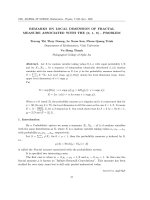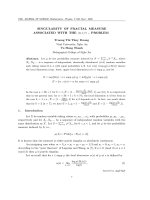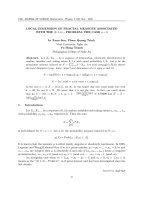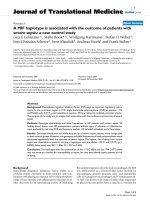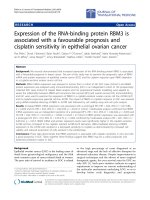Host feeding of mosquitoes (diptera culicidae) associated with the recurrence of rift valley fever in egypt
Bạn đang xem bản rút gọn của tài liệu. Xem và tải ngay bản đầy đủ của tài liệu tại đây (267 KB, 7 trang )
Seediscussions,stats,andauthorprofilesforthispublicationat:
/>
HostFeedingofMosquitoes(Diptera:
Culicidae)Associatedwiththe
RecurrenceofRiftValleyFeverin
Egypt
ArticleinJournalofMedicalEntomology·December1999
DOI:10.1093/jmedent/36.6.709·Source:PubMed
CITATIONS
READS
29
20
8authors,including:
Abd-AllaGad
RedaRamzy
NationalAuthorityforRemoteSe…
NationalNutritionInstitute
93PUBLICATIONS973CITATIONS
95PUBLICATIONS2,078CITATIONS
SEEPROFILE
SEEPROFILE
StevenMPresley
AliHassan
TexasTechUniversity
InstituteofEnvironmentalStudie…
61PUBLICATIONS490CITATIONS
38PUBLICATIONS341CITATIONS
SEEPROFILE
AllcontentfollowingthispagewasuploadedbyAliHassanon26February2017.
Theuserhasrequestedenhancementofthedownloadedfile.
SEEPROFILE
Host Feeding of Mosquitoes (Diptera: Culicidae) Associated with the
Recurrence of Rift Valley Fever in Egypt
ADEL M. GAD,1 HODA A. FARID,1 REDA R. M. RAMZY,1 MAHMOUD B. RIAD,1
STEVEN M. PRESLEY,2, 3 STANTON E. COPE,2, 4 MOSSAD M. HASSAN,1 AND ALI N. HASSAN1
J. Med. Entomol. 36(6): 709Ð714 (1999)
ABSTRACT In 1993, Rift Valley fever (RVF) virus reappeared in Egypt. We determined the
prevalence and feeding patterns of mosquitoes in 5 villages where the virus was active. Of 10 species
recovered, Aedes caspius (Pallas), Culex pipiens L., Cx. antennatus (Becker), and Cx. perexiguus
Theobald constituted 99% of Ͼ35,000 mosquitoes captured in dry ice-baited CDC light traps. Ae.
caspius was most prevalent, except at NagÕ El Hagar where it was replaced by Cx. perexiguus. Cx.
pipiens ranked 2nd, except at NagÕ El Ghuneimiya, where it was replaced by Cx. antennatus. Most
blood meals analyzed by an enzyme-linked immunosorbent assay reacted to Ն1 antiserum. Cx.
pipiens was mainly anthropophagic, and therefore may have been the main vector of RVF virus
among humans. Ae. caspius feeds were chießy from humans, bovines, and equines. Cx. antennatus and
Cx. perexiguus fed generally on bovines. Mixed blood meals from humans and RVF virus susceptible
animals were identiÞed in the predominant mosquitoes. Prevalence and host selection, as well as
predicted probability for a blood meal being interrupted, indicated that Ae. caspius may have served
as a bridge vector between humans and bovines in 4 of the villages. Cx. perexiguus may have played
this role at NagÕ El Hagar. Because potential vectors are abundant, susceptible domestic animals are
associated closely with humans, and surveillance of imported livestock is not systematic, we conclude
that RVF virus sporadically will recur in Egypt.
KEY WORDS mosquito, blood meal, Rift Valley fever, Egypt
RIFT VALLEY FEVER (RVF) virus was Þrst introduced
into southern Egypt in 1977 from where it rapidly
spread northward to the Nile Delta causing an estimated 600 human deaths as well as abortion and death
in sheep and cattle (Hoogstraal et al. 1979, Meegan
1979). The virus persisted during 1978. After a 12-yr
absence, RVF virus reappeared in May 1993 in southern Egypt, with an estimated 600 Ð1,500 human infections and widespread abortions and deaths in domestic
livestock. Sera collected from sheep, goats, buffalo,
and cattle in the Aswan governorate were positive for
antibodies to RVF virus (Arthur et al. 1993). Evidence
of RVF virus activity also was detected in the Nile
Delta and the Faiyum Oasis (Corwin et al. 1993, WHO
1994).
To acquire RVF virus, mosquitoes must feed on
viremic mammals; therefore, it is important to understand mosquito host-feeding patterns. During the
1977Ð1978 epidemics, Culex pipiens L. was implicated
as the primary vector of RVF virus, based on a single
virus isolation from an unengorged female (Hoogstraal et al. 1979) and its blood feeding habits (Kenawy
1
Research and Training Center on Vectors of Diseases, Ain Shams
University, Cairo, Egypt.
2
Naval Medical Research Unit No. 3, Abbassia, Cairo, Egypt.
3
Current address: Training Programs Br C 462, Marine Corps Combat Development Command, 3300 Russell Road, Quantico, VA 22134 Ð
5001.
4
Current address: Navy Environmental Health Center, 2510
Walmer Avenue, Norfolk, VA 23513.
et al. 1987, Gad et al. 1995). Aedes caspius (Pallas) and
Cx. antennatus (Becker) were suspected of disseminating the virus among livestock, based on feeding
patterns (Kenawy et al. 1987, Gad et al. 1995) and
vector competence (Gad et al. 1987). However, these
studies of host selection by mosquitoes (Zimmerman
et al. 1985) were carried out after RVF virus was last
documented in 1981 (Imam et al. 1981).
During the RVF virus outbreak in 1993, we initiated
a multidisciplinary study in Aswan governorate. Entomological efforts determined the prevalence and
host feeding patterns of mosquitoes at 5 villages where
human or livestock disease was occurring.
Materials and Methods
Mosquito Collections. Mosquitoes were sampled
from 14 to 24 August 1993 in the Aswan governorate
on the southernmost part of the Nile Valley in 5 agricultural villages north of Aswan City (Fig. 1) where
animal and human RVF virus infections were occurring. The villages were environmentally and socioeconomically similar. Houses generally were associated
with animal sheds where domestic animals (horses,
donkeys, cattle, buffalo, goats, sheep, and poultry)
were kept at night. Epidemiological investigations in
NagÕ El Hagar and Sabil Abu El Magd revealed that the
human population exceeded 2,000 in each village. Animal host censuses included only those animals susceptible to RVF virus. In NagÕ El Hagar (n ϭ 44
0022-2585/99/0709Ð0714$02.00/0 ᭧ 1999 Entomological Society of America
710
JOURNAL OF MEDICAL ENTOMOLOGY
Fig. 1. Mosquito collection sites in Southern Egypt
(numbered).
households), bovines (cattle only) and ovines (sheep
and goats) constituted 13.5 and 86.5%, respectively, of
the livestock (n ϭ 252). Host populations consisted of
7.4 humans, 0.8 bovines, and 5.0 ovines per household.
In Sabil Abu El Magd (n ϭ 52 households), bovines
(cattle and buffaloes) and ovines accounted for 36.5
and 63.5%, respectively, of the livestock (n ϭ 214).
There were 7.0 humans, 1.5 bovines, and 2.6 ovines per
household. Houses mostly were surrounded by sugarcane Þelds except in NagÕ El Hagar. Mosquitoes
were collected by dry ice-baited traps (without light)
operated from sunset to sunrise. Blood-fed mosquitoes
were recovered from these traps, and on a few occasions collected resting inside buildings. From 7 to 28
traps per village per night were hung outdoors on trees
or streetlights near houses on the edges of cultivated
Þelds during 6 consecutive nights in NagÕ El Hagar, 4
in Sabil Abu El Magd, and 2 in El Raghama. NagÕ El
Ghuneimiya and El Naghaghra were each sampled
once, because these villages had been treated with
insecticides after the 1st night. Traps were checked
every 2 h and the catching net replaced when full of
insects. Specimens were identiÞed on dry ice accord-
Vol. 36, no. 6
ing to the keys of Gad (1963) and Harbach (1985).
Blood-fed mosquitoes were separated by species and
location, each group placed in a labeled screwcap vial
and stored at Ϫ70ЊC until tested for blood meal source
at Ain Shams University.
Blood Meal Identification. Only mosquitoes captured in traps were tested. Blood meals were identiÞed
using the direct enzyme immunoassay (EIA) developed by Beier et al. (1988), with slight modiÞcation.
Brießy, individual mosquitoes were homogenized in
phosphate buffered saline. Polyvinyl chloride plates
(Falcon 3912 microtiter plates, Becton Dickinson, Oxnard, CA) were sensitized by incubating each mosquito homogenate in duplicate wells. Plates then were
washed with PBS containing 0.05% Tween 20, and 50
l of host-speciÞc peroxidase conjugate (human, bovine, ovine, equine, canine, cat, rat, and chicken,
Sigma, St. Louis, MO), diluted at 1:2000 (or 1:250 for
bovine) in boiled casein, were added to each well.
Plates were incubated, washed and optical densities at
410 nm determined with an enzyme-linked immunosorbent assay (ELISA) reader (MR 4000 Dynatech,
Alexandria, VA) 15 min after the addition of ABTS
peroxidase substrate (Kirkegaard & Perry, Gaithersburg, MD). Positive controls consisting of mixed unfed
mosquitoes and host blood from our sera bank, and
negative controls consisting of unfed mosquitoes were
included on each microtiter plate. To decrease cross
reactivity, heterologous serum (8 hosts) was added to
the conjugate solution for each test. Positive samples
were those with absorbance values exceeding mean
plus 3 times the standard deviation of the negative
controls. Multiple feedings were detected by repeating the assay for the whole range of hosts tested. The
probability of interrupted feeding was determined as
in Burkot et al. (1988) and assumed that the probability of interruption was the same for human and
nonhuman hosts. Only meals containing blood from
humans and ovines or bovines were used to evaluate
mosquito feeding behavior regarding hosts susceptible
to RVF virus (Ghoneim and Woods 1983).
Results
Prevalence of adult mosquitoes varied among the 5
study villages (Table 1). From 4 to 10 species were
recovered from each village. Ae. caspius, Cx. pipiens,
Cx. antennatus, and Cx. perexiguus were collected from
all 5 villages where they constituted 98.7% of the
35,289 specimens. Of the specimens collected, 664
were blood-fed to repletion. Mosquito species each
with Ͻ1% prevalence were Cx. poicilipes (Theobald),
Uranotaenia unguiculata Edwards, Anopheles pharoensis Theobald, An. tenebrosus Doenitz, An. sergentii
(Theobald), and An. multicolor Cambouliu. Two to 4
species were abundant (at least 5%) in each village. Ae.
caspius predominated, except at NagÕ El Hagar where
Cx. perexiguus was most prevalent. Cx. pipiens ranked
2nd in prevalence, except at NagÕ El Ghuneimiya
where it was replaced by Cx. antennatus. The pattern
of mosquito abundance in the study villages followed
that observed for species prevalence. An average 30.3Ð
November 1999
GAD ET AL.: MOSQUITO HOSTS IN VILLAGES INFECTED WITH RVF VIRUS
711
Table 1. Mosquito species composition determined by CO2-baited CDC traps (without light) from rural villages in Aswan governorate,
14 –24 August 1993
% of total females
Mosquito species
NagÕ El Ghuneimiya
(18)
El Raghama
(42)
El Naghaghra
(7)
Sabil Abu El Magd
(68)
NagÕ El Hagar
(89)
Ae. caspius
Cx. pipiens
Cx. antennatus
Cx. perexiguus
Total specimensa
No. per trap-night
43.53
12.25
32.43
8.71
2,433
135.2
79.81
19.39
0.39
0.41
5,353
127.5
65.15
12.67
12.28
0.40
505
72.4
93.56
4.70
0.67
0.02
8,514
125.2
14.60
28.28
9.49
46.04
18,484
207.7
Numbers in parentheses represent total trap-nights.
Including mosquito species with Ͻ1% prevalence each (Cx. poicilipes, U. unguiculata, An. pharoensis, An. tenebrosus, An. sergentii, An.
multicolor).
a
17.1 female Ae. caspius were collected per trap-night
per village. Other predominant mosquitoes were less
abundant: with 5.9 Ð58.7 female per trap-night per village for Cx. pipiens, 0.5Ð 43.8 for Cx. antennatus and
Ͻ0.1Ð95.6 for Cx. perexiguus. Average mosquito density was lowest at El Naghaghra and highest at NagÕ El
Hagar (Table 1).
Of 664 blood engorged mosquitoes analyzed by EIA,
92.2% reacted to Ն1 antiserum (Table 2) and 14.9% of
these reacted to Ն2 antisera. Large mammals (humans, bovines and equids) constituted most hosts
identiÞed for the predominant mosquitoes (Table 2).
Ae. caspius fed frequently on human, bovine and
equine hosts, although this pattern varied among villages (Table 3) (2 ϭ 46.7, df ϭ 16, P Ͻ 0.01). Frequent
human feeds by this mosquito were observed in
Raghama and NagÕ El Hagar. In Sabil Abu El Magd
females fed predominantly on large mammals. Ovine
feeds by this mosquito were more frequent in
Raghama than in the other 2 villages. Cx. pipiens was
mainly anthropophagic (Table 3). The proportional
meals consisting of human, bovine, equine and ovine
blood did not vary among villages for this species (2 ϭ
10.1, df ϭ 6, P Ͼ 0.05). Cx. antennatus and Cx. perexiguus fed mostly on bovines (Table 2). Ovine feeds by
predominant mosquitoes were 2.8%. Dog, rat, cat and
chicken feeds amounted to 3.4% for Ae. caspius, 5.4%
for Cx. pipiens, 8.3% for Cx. antennatus, and 9.0% for Cx.
perexiguus. All 4 mosquitoes fed on unidentiÞed hosts.
Of 28 An. tenebrosus, 89.3 and 10.7% fed on humans and
bovines, respectively. Two human and 1 equine feeds
were detected for 3 An. pharoensis. One An. multicolor
fed on horse blood, whereas 1 unidentiÞed blood meal
was from U. unguiculata.
Mixed meals were recognized in the 4 predominant
mosquitoes from all 5 villages, and also in An. tenebrosus (Table 4). Of 99 mixed blood meals, 91% were
Table 2.
double feeds and 9% were triple feeds. Mosquito feeds
containing blood from humans and RVF virus susceptible animals (bovines or ovines) constituted 28.3% of
multiple feeds and 4.2% of all blood meals. Such feeds
were 35.3 and 14.8% of mixed meals by Ae. caspius from
NagÕ El Hagar (n ϭ 17) and Sabil Abu El Magd (n ϭ
27), respectively, and 40.7% of those by Cx. pipiens
from NagÕ El Hagar (n ϭ 27). Mosquito feeds containing human blood and blood from nonsusceptible
RVF virus animals were 26.3 and 3.9% of multiple and
total meals, respectively. Such mixed blood meal
groups constituted 58.8 and 3.7% of Ae. caspius meals
from NagÕ El Hagar and Sabil Abu El Magd respectively, and 22.2% of Cx. pipiens meals from NagÕ El
Hagar. Overall, the probability of a blood meal being
interrupted was 0.10. In villages where Ͼ100 meals
were tested, the proportion of mixed meals estimated
the probability of interruption of a meal by Ae. caspius
(Table 5). The predicted probability for interrupted
meals by this species was 0.096 in NagÕ El Hagar and
0.043 in Sabil Abu El Magd.
Discussion
Of 14 mosquito species known to occur in the
Aswan governorate (Kenawy et al. 1987), 10 were
recovered from villages where cases of RVF virus
infections were reported. Serological evidence of infections came from blood samples collected during the
same period and region from humans and livestock
(Arthur et al. 1993). Ae. caspius, Cx. pipiens, Cx. perexiguus, and Cx. antennatus predominated in outdoor
trap collections. No systematic indoor collections
were made. However, only Ae. caspius (n ϭ 102) were
found resting in 2 bedrooms at Sabil Abu El Magd.
Females (n ϭ 14) of this species were recovered in 1
bedroom at NagÕ El Hagar as well. Other sampling
Single blood meal hosts of mosquitoes collected from Aswan governorate, 14 –24 August 1993
Mosquito species
Ae. caspius
Cx. pipiens
Cx. antennatus
Cx. perexiguus
n
318
112
36
67
Blood meal hosts (% total)
Human
Bovine
Ovine
Equine
Dog
Cat
Rat
Chicken
Nonreactor
38.4
59.8
13.9
8.9
26.4
9.8
30.6
50.7
3.8
1.8
0.0
1.5
23.3
7.1
19.4
16.5
1.9
0.9
5.5
0.0
0.3
0.0
0.0
1.5
0.6
0.0
2.8
4.5
0.6
4.5
0.0
3.0
4.7
16.1
27.8
13.4
712
JOURNAL OF MEDICAL ENTOMOLOGY
Table 3.
Vol. 36, no. 6
Single blood meal hosts of mosquitoes collected from villages in Aswan governorate, 14 –24 August 1993
Mosquito tested in
village
Ae. caspius
Raghama
Sabil Abu El Magd
NagÕ El Hagar
Cx. pipiens
Raghama
Sabil Abu El Magd
NagÕ El Hagar
Blood meal hosts (% total)
n
Human
Bovine
Equine
Ovine
Dog
Cat
Rat
Chicken
Nonreactor
40
157
108
40.0
28.0
57.4
17.5
31.2
19.4
20.0
32.6
11.1
10.0
3.2
2.8
2.5
1.9
1.9
0.0
0.6
0.0
0.0
0.6
0.0
0.0
0.0
1.9
10.0
1.9
5.5
41
15
52
65.8
46.7
57.7
4.9
33.3
7.7
9.7
13.3
3.8
2.5
0.0
1.9
0.0
0.0
1.9
0.0
0.0
0.0
0.0
0.0
0.0
4.9
0.0
5.8
12.2
6.7
21.2
methods might have produced a different pattern.
Indeed, an earlier study carried out in the Aswan
governorate (Kenawy et al. 1987) revealed that although Ae. caspius prevailed outdoors, and Cx. pipiens
represented 95% of indoor collections.
The predominant species fed on large mammalian
hosts including humans, bovines, equines, and to a
much lesser extent, ovines. Vector competence studies of mosquitoes collected in epizootic areas during
the 1993 outbreak (Turell et al. 1996) revealed that the
4 predominant species were susceptible to infection
and able to transmit RVF virus. We suggest that these
mosquitoes were the chief vectors of RVF virus in the
5 villages studied. Earlier reports of mosquito blood
feeding in Egypt were based on precipitin tests and
failed to detect mixed meals (Gad et al. 1995). The EIA
currently used revealed that mixed meals including
human and bovine or ovine blood were common in the
predominant species from all 5 villages, particularly
Ae. caspius, indicating that a signiÞcant proportion of
the mosquito population in Aswan governorate acted
Table 4. Multiple blood meal sources of mosquitoes in Aswan
governorate, 14 –24 August 1993
% mosquito blood meal hosts
Blood meal
Ae.
caspius
Cx.
pipiens
Cx.
perexiguus
All
species
Human/Bovine
Human/Equine
Human/Ovine
Human/Dog
Human/Rat
Human/Chicken
Bovine/Equine
Bovine/Ovine
Bovine/Dog
Bovine/Rat
Equine/Ovine
Equine/Dog
Equine/Rat
Human/Bovine/Equine
Human/Bovine/Ovine
Human/Equine/Ovine
Human/Ovine/Dog
Human/Ovine/Rat
Bovine/Equine/Ovine
Bovine/Ovine/Cat
Bovine/Ovine/Rat
Total
14.6
20.8
4.1
2.1
4.1
0.0
27.1
2.1
2.1
8.3
6.3
0.0
2.1
2.1
0.0
0.0
0.0
0.0
2.1
2.1
0.0
48
14.8
14.8
17.7
0.0
8.8
2.9
2.9
23.6
0.0
0.0
0.0
0.0
0.0
0.0
2.9
2.9
2.9
2.9
0.0
0.0
2.9
34
10.0
0.0
0.0
0.0
10.0
0.0
30.0
0.0
10.0
0.0
20.0
10.0
0.0
0.0
0.0
0.0
0.0
0.0
0.0
0.0
10.0
10
15.2
15.2
8.1
1.0
9.1
1.0
18.2
9.1
3.0
4.0
5.1
1.0
1.0
1.0
1.0
1.0
1.0
1.0
1.0
1.0
2.0
99a
a
Including blood meals by Cx. antennatus (1 human/bovine, 2
human/rat, 1 bovine/equine, 1 bovine/dog) and An. tenebrosus (1
human/bovine, 1 human/rat).
as a bridge vector of RVF virus between humans and
susceptible animals. Based on abundance, feeding behavior, susceptibility to infection, and ability to transmit the virus, Ae. caspius may have played an important
role in RVF virus transmission in at least 4 of the
villages, serving as the major bridge vector between
humans and bovines. Furthermore, interrupted feeds
between humans and ovines or bovines by this mosquito indicated frequent host contacts among these
hosts, in villages where it predominated. Ae. caspius
was suspected of disseminating RVF virus among animal populations during the 1977Ð1978 epidemics
(Kenawy et al. 1987). In the Aswan governorate, it is
associated closely with sugar cane plantations. In NagÕ
El Hagar, where there were no sugarcane Þelds when
collections were made, Cx. perexiguus predominated,
feeding mainly on bovines, but also on humans, and
therefore acting as the primary link between animals
and humans in that village. Cx. pipiens was the 2nd
most abundant mosquito, except at NagÕ El Ghuneimiya. Its marked anthropophagy indicated that it may
have been the main vector of RVF virus among humans. Earlier studies reported similar observations for
Cx. pipiens from the Aswan (Kenawy et al. 1987) and
Sharqiya (Gad et al. 1995) governorates. Zoophagy
was reported for females from Gharbiya governorate
(Zimmerman et al. 1985). In the Faiyum Oasis, this
species exhibited an elevated forage ratio for bovines
and ovines (Beier et al. 1986). Much of the geographic
variation in host-feeding by mosquito species in Egypt
has been attributed to relative host abundance, which
is largely a reßection of ecological conditions and
human customs (Zimmerman et al. 1985, Beier et al.
1987). Because ovines were abundant in Sabil Abu El
Magd and NagÕ El Hagar, the low number of ovine
feeds could not be related to low sheep/goat populations in these villages. Cx. antennatus constituted
approximately one-third of collected mosquitoes and
fed mainly on bovines, as well as humans and other
large mammals. This mosquito may have been the
main link vector for RVF virus between humans and
animals in Sharqiya (Gad et al. 1995). Interestingly,
Ϸ42% of Cx. antennatus feeds were unidentiÞed. In the
Nile Delta, this mosquito fed exclusively on large
mammals (Zimmerman et al. 1985), with a marked
preference for ovines (Gad et al. 1995). Its host range
is wider in other parts of Africa, where it appears to
feed on large mammals as well as birds (Chandler et
al. 1975, 1976). However, few Cx. antennatus fed on
November 1999
Table 5.
GAD ET AL.: MOSQUITO HOSTS IN VILLAGES INFECTED WITH RVF VIRUS
713
Probability that Ae. caspius feeding on humans takes a multiple blood meal
Predicted
Village
No. human
meals
No. mixed
human mealsa
Total
meals
Proportion mixed
human meals
Qb
IHc
Sabil Abu El Magd
NagÕ El Hagar
44
62
3
6
184
125
0.016
0.048
0.247
0.520
0.043
0.096
a
Meal with human and bovine or ovine blood.
Q, proportion of meals with only human blood ϩ (proportion of mixed human meals/2).
Assuming IH ϭ IN ϭ probability of interruption of a human (IH) or nonhuman (IN) blood meal ϭ proportion of mixed blood meals/2Q
(1 Ð Q).
b
c
domestic birds in Lower Egypt and unidentiÞed feeds
by this mosquito did not react with general bird antisera (Gad et al. 1995). Therefore, it is doubtful that
most nonreacting blood meals by Cx. antennatus were
from wild birds. Our Þndings demonstrated that the 4
dominant mosquito species feed on a wide variety of
hosts, and thus are quite opportunistic in their feeding
behavior, conÞrming earlier reports (Kenawy et al.
1987, Gad et al. 1995). This is important because these
mosquitoes may have served as a bridge vector between humans and domestic animals.
The basic transmission cycle of RVF virus in Egypt,
although poorly understood, differs from that in subSaharan Africa where infections recur after particularly wet seasons. No true ßoodwater mosquito species
occur in Egypt, where the agricultural land is irrigated
regularly and therefore not exposed to drought
periods. Moreover, although Ae. caspius lays droughtresistant eggs (unpublished data), vertical transmission of RVF virus by this species is questionable, because no transovarial transmission seems to occur in
aedines (Macintosh and Jupp 1981) or in Cx. pipiens
(Turell et al. 1984, Romoser et al. 1992). Furthermore,
no animal reservoir host has been demonstrated
(Hoogstraal et al. 1979). Therefore, it is most likely
that RVF virus does not become established, but
rather has to be reintroduced into Egypt. Camels
(Hoogstraal et al. 1979) or sheep (Gad et al. 1986)
smuggled from Sudan are thought to have introduced
the virus into Egypt in 1977, and the same scenario
may have been repeated.
Several possible modes of RVF virus transmission
have been contemplated. Biological transmission of
RVF virus from viremic livestock to vectors to other
vertebrates has been generally admitted. High viremias occurred in infected humans and livestock
(Hoogstraal et al. 1979, Meegan 1979) and were sufÞcient to infect potential vectors (Turell et al. 1996).
Therefore, both humans and domestic animals may
have served as an important source of infection. Furthermore, because of high titered viremias in vertebrate hosts, mechanical transmission by mosquitoes
was suspected during the 1977 epizootic/epidemic
(Hoogstraal et al. 1979, Meegan and Bailey 1988).
Mechanical transmission has been demonstrated experimentally in Cx. pipiens (Hoch et al. 1985), which
were able to transmit RVF virus by probing, even if
they failed to feed (Gargan et al. 1983). This, combined with abundance in areas where RVF virus occurs, may extend the importance of interrupted feed-
ing by infected Cx. pipiens, because it would increase
its chances of transmitting RVF virus. However, no
data exist regarding mechanical transmission by other
potential vectors, so that interrupted feeding by such
mosquitoes only indicated their potential for increased transmission. Aerosol transmission from vertebrates to humans by inhalation of virus during animal slaughtering (Hoogstraal et al. 1979) and
transmission through contact with infected animal tissues (Van Velden et al. 1977) have been documented.
Therefore, as long as humans live in close association
with susceptible domestic animals, and without systematic surveillance of livestock introduced through
Sudan, RVF virus sporadically will be imported into
Egypt. This statement is supported by our study,
which demonstrated that 12 yr after the 1st RVF virus
epidemic, potential vectors that feed on both humans
and animals remain available, and could contribute to
the dissemination of RVF virus in Egypt.
Acknowledgments
This study was supported in part by the Research and
Training Center on Vectors of Diseases, Ain Shams University.
References Cited
Arthur, R. R., M. S. El-Sharkawy, S. E. Cope, B. A. Botros, S.
Oun, J. C. Morrill, R. E. Shope, R. G. Hibbs, M. A.
Darwish, and I.Z.E. Imam. 1993. Recurrence of Rift Valley fever in Egypt. Lancet (Lond.) 342: 1149 Ð1150.
Beier, J. C., M. A. Kenawy, S. El Said, and A. I. Merdan. 1986.
Vector potential of culicine mosquitoes in Faiyum Governorate, Egypt. J. Am. Mosq. Control Assoc. 2: 164 Ð167.
Beier, J. C., P. V. Perkins, R. A. Wirtz, J. Koros, D. Diggs, T. P.
Gargan II, and D. K. Koech. 1988. Blood meal identiÞcation by direct enzyme-linked immunosorbent assay
(ELISA), tested on Anopheles (Diptera: Culicidae) in
Kenya. J. Med. Entomol. 25: 9 Ð16.
Beier, J. C., J. H. Zimmerman, M. A. Kenawy, S. El Said, and
M. M. Abbassy. 1987. Host-feeding patterns of the mosquito community (Diptera: Culicidae) in two Faiyum
Governorate villages, Egypt. J. Med. Entomol. 24: 28 Ð34.
Burkot, T. R., P. M. Graves, R. Paru, and M. Lagog. 1988.
Mixed blood feeding by the malaria vectors in the Anopheles punctatus complex (Diptera: Culicidae). J. Med. Entomol. 25: 205Ð213.
Chandler, J. A., P.F.L. Boreham, R. B. Highton, and M. N.
Hills. 1975. A study of the host selection patterns of the
mosquitoes of the Kisumu area in Kenya. Trans. R. Trop.
Med. Hyg. 69: 415Ð 425.
714
JOURNAL OF MEDICAL ENTOMOLOGY
Chandler, J. A., R. B. Highton, and P.F.L. Boreham. 1976.
Studies on some ornithophilic mosquitoes (Diptera, Culicidae) of the Keno Plain, Kenya. Bull. Entomol. Res. 66:
33Ð143.
Corwin, A., M. Habib, D. Watts, J. Olson, M. Darwish, R.
Hibbs, B. Botros, M. Kleinosky, R. Shope, and M. Kilpatrick. 1993. Prevalence of antibody to Rift Valley fever virus in the Nile river Delta of Egypt, 13 years after
a major outbreak. J. Egypt. Public Health Assoc. 53: 153Ð
162.
Gad. A. M. 1963. Insects of medical importance. Institute of
Medical Entomology, Ministry of Public Health. Dokki,
Cairo, Egypt (in Arabic).
Gad, A. M., F. M. Feinsod, I. H. Allam, M. Eisa, A. N. Hassan,
B. A. Soliman, S. El Said, and A. J. Saah. 1986. A possible
route for the introduction of Rift Valley fever into Egypt
during 1977. J. Trop. Med. Hyg. 89: 233Ð236.
Gad, A. M., M. M. Hassan, S. El Said, M. I. Moussa, and O. L.
Wood. 1987. Rift Valley fever virus transmission by different Egyptian mosquito species. Trans. R. Soc. Trop.
Med. Hyg. 81: 694 Ð 698.
Gad, A. M., I. M. Riad, and H. A. Farid. 1995. Host-feeding
patterns of Culex pipiens and Culex antennatus (Diptera:
Culicidae) from a village in Sharqiya Governorate, Egypt.
J. Med. Entomol. 32: 573Ð577.
Gargan, T. P. II, C. L. Bailey, G. A. Higbee, A. Gad, and S. El
Said. 1983. The effect of laboratory colonization on the
vector-pathogen interactions of Egyptian Culex. pipiens
and Rift Valley fever virus. Am. J. Trop. Med. Hyg. 32:
1154 Ð1163.
Ghoneim, N. H., and T. G. Woods. 1983. Rift Valley fever
and its epidemiology in Egypt: a review. J. Med. 14: 55Ð79.
Harbach, R. E. 1985. Pictorial keys to the genera of mosquitoes, subgenera of Culex and the species of Culex
(Culex) occurring in southwestern Asia and Egypt, with
a note on the subgeneric placement of Culex deserticola
(Diptera: Culicidae). Mosq. Syst. 17: 83Ð107.
Hoch, A. L., T. P. Gargan, and C. L. Bailey. 1985. Mechanical transmission of Rift Valley fever virus by hematophagous Diptera. Am. J. Trop. Med. Hyg. 34: 188 Ð193.
Hoogstraal, H., J. M. Meegan, G. M. Khalil, and F. K. Adham.
1979. The Rift Valley fever epizootic in Egypt, 1977Ð78.
View publication stats
Vol. 36, no. 6
2. Ecological and entomological studies. Trans. R. Soc.
Trop. Med. Hyg. 73: 624 Ð 629.
Imam, Z. E., R. El-Karamany, F. Omar, and O. El-Kafrawy.
1981. Rift Valley fever in Egypt. J. Egypt. Public Health
Assoc. 56: 356 Ð383.
Kenawy, M. A., J. C. Beier, J. H. Zimmerman, S. El Said, and
M. M. Abbassy. 1987. Host feeding patterns of the mosquito community (Diptera: Culicidae) in Aswan Governorate, Egypt. J. Med. Entomol. 24: 41Ð 45.
Macintosh, B. M., and P. G. Jupp. 1981. Epidemiological
aspects of Rift Valley fever in South Africa with reference
to vectors. Control Epidemiol. Biostatist. 3: 92Ð99.
Meegan, J. M. 1979. The Rift Valley fever epizootic in 1977Ð
78. I. Description of the epizootic and virological studies.
Trans. R. Soc. Trop. Med. Hyg. 73: 618 Ð 623.
Meegan, J. M., and C. L. Bailey. 1988. Rift Valley fever, pp.
51Ð75. In T. P. Monath [ed.], The arboviruses: epidemiology and ecology, vol. 4. CRC, Boca Raton, FL.
Romoser, W. S., M. E. Faran, C. L. Bailey, and K. Lerdthusnee. 1992. An immunocytochemical study of the distribution of Rift valley fever virus in the mosquito Culex
pipiens. Am. J. Trop. Med. Hyg. 6: 489 Ð501.
Turell, M. J., T. P. Gargan, and C. L. Bailey. 1984. Replication and dissemination of Rift Valley fever virus in Culex
pipiens. Am. J. Trop. Med. Hyg. 33: 176 Ð181.
Turell. M.J., S. M. Presley, A. M. Gad, S. E. Cope, D. J. Dohm,
J. C. Morrill, and R. R. Arthur. 1996. Vector competence
of Egyptian mosquitoes for Rift Valley fever virus. Am. J.
Trop. Med. Hyg. 54: 136 Ð139.
WHO. 1994. Rift Valley fever. WHO Wkly. Epidemiol. Rec.
69: 74.
Van Velden, D.J.J., J. D. Meyer, J. Olivier, J.H.S. Gear, and
B. Macintosh. 1977. Rift Valley fever affecting humans
in South Africa: a clinicopathological study. S.A. Med. J.
51: 867Ð 871.
Zimmerman, J. H., H. A. Hanafi, and M. M. Abbassy. 1985.
Host-feeding patterns of Culex mosquitoes (Diptera: Culicidae) on farms in Gharbiya Governorate, Egypt. J. Med.
Entomol. 22: 82Ð 87.
Received for publication 29 January 1998; accepted 8 June
1999.

